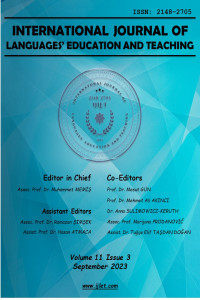Öz
İlgi Tümcesi (İT), bir ismi tanımlayan bağımlı bir yan tümcedir. İT'ler bir ismi
betimler, tanımlar veya onunla ilgili daha fazla bilgi verir. İT'leri -(y)an, -dık, vb.
veya -mış gibi bir ilgi zamiri ile başlar. Bununla birlikte ilgi zamirleri bazen
İngilizce'de atılabilir. Bu da İT'lerin kısaltma biçimine neden olur. Türkçe'de ise
İngilizce'deki ne ayrı yazılan ilgi zamirleri ne de İT'lerde görülen kısaltma
biçimleri vardır. Bu da İngilizce'den Türkçe'ye çeviride zorluklara neden olabilir.
Bu çalışma, bu zorlukların neler olduğunu ve İT'lerde veya kısaltılmış İT'lerde
etken ve edilgen yapı kullanımının durumuna bağlı olarak bu zorlukların nasıl
farklılaştığını analiz etmeyi amaçlamaktadır. Bu çalışmada, çeviri bölümü
öğrencilerine Öğrenci Seçme ve Yerleştirme Merkezi (ÖSYM) tarafından yapılan
Yabancı Dil Sınavlarından elde edilen bir dizi soru uygulanmıştır. Hazırlanan
testi çevrimiçi platformda tamamlayan öğrencilerin çevrilmesi zor olan ifadeler
ve cümlelerin uzunluğunun yanı sıra çoktan seçmeli testteki çeldirici şıklar
nedeniyle kısaltılmamış etken cümle sorularında daha çok hata yaptıkları
görülmüştür. Öte yandan aynı cümleleri İngilizce'den Türkçe'ye kendileri çeviren
öğrencilerin ise edilgen kısaltılmış İT’lerde, cümlede anlam belirsizliğinden
dolayı daha çok zorluk yaşadıklarını ortaya koymuştur. Bu çalışmanın, çeviri
öğrencilerinin kısaltılmış İT'lerdeki anlamın belirsizliğinin farkında olmalarına
yardımcı olması beklenmektedir.
Anahtar Kelimeler
İlgi tümcesi Kısaltma Tanımlayıcı / Tanımlayıcı olmayan cümle Yan cümle Çeviri
Kaynakça
- Aydın, Ö. (2007). The Comprehension of Turkish Relative Clauses in second language acquisition and agrammaticism. Applied Psycholinguistics, 28, 295- 315.
- Bever, T.G (1970). The cognitive basis for linguistic structures. In: J.R. Hayes, Editor, Cognition and the development of language, Wiley, New York (1970), pp. 279–362.
- Brown, T.D. (2001). Using surveys in language programs. Cambridge: Cambridge University Press, 2001.
- Carrol, D. W. (2008). Psychology of Language (5 ed.). Belmont: Thomson & Wadsworth.
- Çağrı, İ. (2005). Minimality and Turkish Relative Clauses. Yayınlanmamış Doktora tezi, University of Maryland College Park.
- Diessel, Holger. (2005). A new look at the acquisition of relative clauses. Language, 81, 882-906.
- Juffs, A. (1998). Main Verb Versus Reduced Relative Clause Ambiguity Resolution in L2 Sentence Processing. Language Learning 48 (1): 107–147.
- Keenan, E., & Comrie, B. (1977). Noun phrase accessibility and universal grammar. Linguistic Inquiry, 8, 63-99.
- Özge, D. (2010). Mechanisms and strategies in the processing and acquisition of relative clauses in Turkish monolingual and Turkish-English bilingual children. (Doctoral dissertation). Retrievedfrom METU Library.
- Özsoy, A. S. (1994). Türkçe’de Ortaç Yapısı [Relative Clause Structure in Turkish]. Dilbilim Araştırmaları, [Linguistic Investigations], 21-30. Ankara: Hitit Yayınevi
- Hsu, C. H. (2006). Issues in head-final relative clauses in Chinese: Derivation, processing, and acquisition. Ph.D. dissertation, University of Delaware.
- Solak, E. (2019). International Conference on Turkic Languages Processing. Retrieved on 6 June 2022
- Townsend, D. J. & Bever, T. G. (2001). Sentence Comprehension: The Integration of Habits and Rules. Cambridge: MIT Press.
- Underhill, R. (1972). Turkish participles. Linguistic Inquiry, 3, 87-99.
Öz
A relative clause (RC) is a dependent clause that modifies a noun. It describes, identifies, or gives details about a noun. RCs begin with a relative pronoun or relativizer: a wh- or that. Relative pronouns might be omitted in English, which results in the reduction form of RCs. Turkish, however, has neither relative pronouns nor a reduction in RCs, which may result in challenges in translation from English into Turkish. This study aims to analyse what these challenges are and how they differ depending on the condition of active and passive voice use in RCs or reduced RCs. By applying a set of questions gathered from Foreign Language Exams administered to the translation students, the present study revealed that students taking the online test had more errors in the questions of non-reduced active RC sentences, which might be related to the length of the sentences, the phrases hard to translate, and other tricky options in the multiple choice test while students translating from the scratch had more difficulty in answering reduced passive RCs because of the temporal ambiguity in meaning. It is expected that this study will help student translators be aware of the ambiguity of meaning in reduced RCs.
Anahtar Kelimeler
Relative clause Reduction Defining/ non-defining clause Subordinate clause Translation
Kaynakça
- Aydın, Ö. (2007). The Comprehension of Turkish Relative Clauses in second language acquisition and agrammaticism. Applied Psycholinguistics, 28, 295- 315.
- Bever, T.G (1970). The cognitive basis for linguistic structures. In: J.R. Hayes, Editor, Cognition and the development of language, Wiley, New York (1970), pp. 279–362.
- Brown, T.D. (2001). Using surveys in language programs. Cambridge: Cambridge University Press, 2001.
- Carrol, D. W. (2008). Psychology of Language (5 ed.). Belmont: Thomson & Wadsworth.
- Çağrı, İ. (2005). Minimality and Turkish Relative Clauses. Yayınlanmamış Doktora tezi, University of Maryland College Park.
- Diessel, Holger. (2005). A new look at the acquisition of relative clauses. Language, 81, 882-906.
- Juffs, A. (1998). Main Verb Versus Reduced Relative Clause Ambiguity Resolution in L2 Sentence Processing. Language Learning 48 (1): 107–147.
- Keenan, E., & Comrie, B. (1977). Noun phrase accessibility and universal grammar. Linguistic Inquiry, 8, 63-99.
- Özge, D. (2010). Mechanisms and strategies in the processing and acquisition of relative clauses in Turkish monolingual and Turkish-English bilingual children. (Doctoral dissertation). Retrievedfrom METU Library.
- Özsoy, A. S. (1994). Türkçe’de Ortaç Yapısı [Relative Clause Structure in Turkish]. Dilbilim Araştırmaları, [Linguistic Investigations], 21-30. Ankara: Hitit Yayınevi
- Hsu, C. H. (2006). Issues in head-final relative clauses in Chinese: Derivation, processing, and acquisition. Ph.D. dissertation, University of Delaware.
- Solak, E. (2019). International Conference on Turkic Languages Processing. Retrieved on 6 June 2022
- Townsend, D. J. & Bever, T. G. (2001). Sentence Comprehension: The Integration of Habits and Rules. Cambridge: MIT Press.
- Underhill, R. (1972). Turkish participles. Linguistic Inquiry, 3, 87-99.
Ayrıntılar
| Birincil Dil | İngilizce |
|---|---|
| Konular | Çeviribilim |
| Bölüm | Araştırma Makalesi |
| Yazarlar | |
| Yayımlanma Tarihi | 30 Eylül 2023 |
| Yayımlandığı Sayı | Yıl 2023 Cilt: 11 Sayı: 3 |


